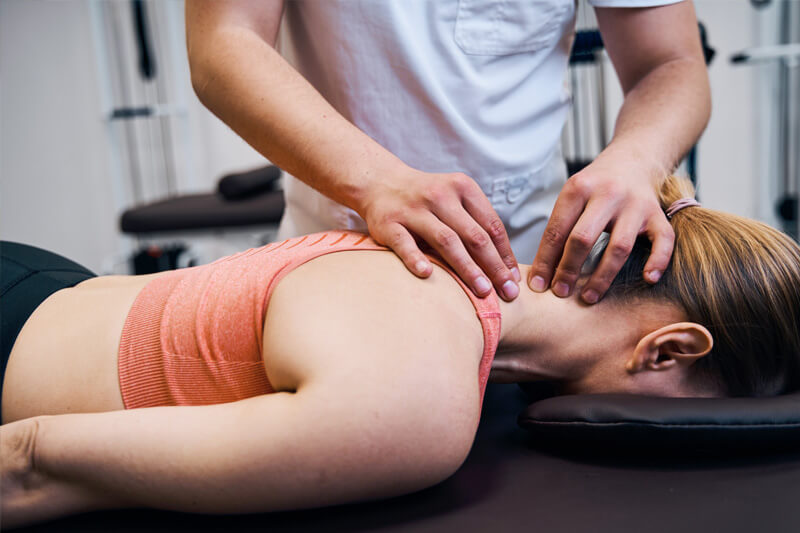Chiropractic care can often relieve neck pain, stiffness, and strain by correcting spine misalignments and relieving nerve pressure. In fact, neck pain is extremely common. About 64% of Australians report neck pain at some point[1] and nearly all chiropractors regularly treat it[2]. Chiropractic adjustments focus on restoring proper joint motion and posture, addressing underlying causes rather than just symptoms[3]. Research notes that up to 70% of people will experience neck pain in their lifetime, and one study found chiropractic care more effective than medication for short and long-term relief[4]. Patients also report high satisfaction with chiropractic: roughly 90% of people said their chiropractic treatment for back/neck issues was helpful[5]. As a result, many patients find chiropractic provides longer-lasting relief than massage or pills alone.
Causes of Neck Stiffness and Strain
Neck stiffness and strain usually arise from a mix of posture and muscular issues. Common causes include:
- Poor posture and “text neck”: Hunching over a screen or looking down at a device for long periods strains the neck muscles and joints[6]. Over time this “forward head” posture can lead to chronic tightness and discomfort.
- Traumatic injury: Whiplash (from car accidents or sports collisions) can violently misalign cervical vertebrae and sprain ligaments, leading to ongoing pain.
- Degenerative conditions: Arthritis, disc wear or herniation in the neck can pinch nerves and cause both pain and stiffness.
- Muscle tension: Chronic stress, repetitive use, or holding static positions tighten the neck and shoulder muscles, restricting motion.
- Spinal misalignments: Joint fixations or instability in the neck can irritate nerves; this may even cause secondary symptoms like headaches or arm pain.
Chiropractic Care vs. Massage for Neck Pain
Both chiropractic and massage can ease neck pain, but they work differently. Chiropractic care targets the spine: practitioners perform manual adjustments and mobilisations to correct misaligned vertebrae, improve joint function, and relieve nerve compression. This often includes posture evaluation and exercise recommendations to address the root problem[3]. Massage therapy, by contrast, works on the soft tissues: it kneads tight muscles and promotes blood flow to relax tension. Massage can give quick, short-term relief and help recovery from muscle knots. In practice, combining both approaches often provides the best outcome. Chiropractic realigns the spine and relieves nerve irritation, while massage helps relax muscles, so together they support a faster and more complete recovery.
What to Expect During a Chiropractic Session
When you visit a chiropractor for neck pain, you can expect a thorough process:
- Assessment and History: The chiropractor will review your symptoms, medical history, and any injuries. They’ll examine your neck and spine alignment, posture, and range of motion.
- Diagnosis and Imaging: They may use digital X-rays or other imaging to check for degeneration, misalignments, or disc issues that could explain your pain.
- Treatment (Adjustments and Therapy): The main treatment is manual spinal adjustments or gentle mobilisations to the neck vertebrae. You may feel a quick release (often with a “popping” sound) as joints realign. The chiropractor may also use soft-tissue techniques (such as trigger-point therapy or gentle massage) to ease surrounding muscle tension.
- Exercises and Advice: You’ll be guided through specific neck and shoulder exercises or stretches to do at home, which help strengthen muscles and maintain the improvement. They will also give posture and ergonomics advice.
After an adjustment, some patients feel mild soreness or stiffness for a day or two. This is normal as the muscles and joints adapt to the realignment. Such soreness usually fades quickly, and most people experience significant pain relief by the next day.
Tips to Prevent Neck Pain and Stiffness
Maintaining good neck health in daily life can reduce pain between treatments. Recommended habits include:
- Regular breaks: Every 20 minutes during computer or phone use, look up and stretch your neck. Even a 20-second break can help reset your posture.
- Gentle stretches: Do neck-friendly exercises like shoulder rolls, head turns, and chin tucks daily to keep muscles flexible.
- Ergonomics: Keep your computer or phone at eye level. Sit with your back supported and shoulders relaxed. An ergonomic workstation goes a long way in preventing “tech neck.”
- Supportive sleeping posture: Use a pillow that keeps your head aligned with your spine (not too high). Side sleepers should tuck a pillow between their arms to avoid twisting the neck.
- Stay active: Regular general exercise (walking, swimming, Pilates, etc.) strengthens your neck, shoulder and core muscles, making your spine more resilient.
When to See a Chiropractor for Neck Pain
If neck pain is persistent, worsening, or severe, it’s wise to get professional help. You should consult a chiropractor if your pain lasts more than a few weeks, keeps you from daily activities, or comes with other symptoms like headaches, arm pain, numbness or tingling. Early treatment is important. Evidence shows that addressing neck issues promptly leads to better outcomes[7]. A chiropractor can diagnose serious causes and design a treatment plan to relieve pain and prevent chronic problems.
Don’t let neck stiffness control your life. Call our chiropractic clinic in Toorak or Doncaster at 0483 960 996 or book online for an evaluation and personalised treatment plan.
Sources:
Chiropractic and musculoskeletal data drawn from Australian studies and surveys[1][4][5][7][8][2][9][10].
- chiro.org.au
- (PDF) A workforce survey of Australian chiropractic: The profile and practice features of a nationally representative sample of 2,005 chiropractors
- New data reveals 87% of Australian adults have experienced a work-related musculoskeletal injury with prevention the best protection.
- Fast facts – Chiropractor, Remedial Massage –
- Using Mobile devices and Computers | ONE HEALTH – Health Centre Port Macquaire
- How Stress Impacts Posture and Pain

